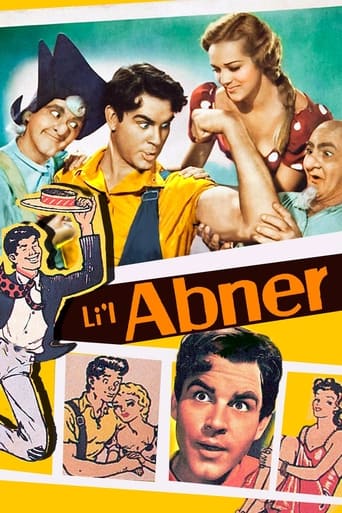arfdawg-1
The Plot.Li'l Abner becomes convinced that he is going to die within twenty-four hours, so agrees to marry two different girls: Daisy Mae (who has chased him for years) and Wendy Wilecat (who rescued him from an angry mob). It is all settled at the Sadie Hawkins Day race.The movie isn't as bad as some reviewers say. It's actually somewhat interesting to see the first renderings of some of these characters.A few giggles here and there and a notable appearance of Buster Keaton as Lonesome Polecat.
gftbiloxi
Al Capp's cartoon strip was so satirically acidic that he was constantly being threatened with suit by the public figures he parodied--and at least one, Joan Baez, actually took him to court. But viewers needn't expect much of Capp's celebrated wit in this 1940 cinematic take on the much-celebrated residents of Dogpatch, USA; more silly than clever and more embarrassing than entertaining, L'IL ABNER has been justly neglected for more than a half a century.Still, it does have a few charms, and most of these are among the cast. Director Albert S. Rogell was a workhorse of the silent era, and the film is crammed to overflowing with a host of silent actors taking one more shot at fame--with the great Buster Keaton the most celebrated name on the roster. Sad to say, they are largely wasted, but we're at least given a chance to see them once more, a decade after their stars faded.The most successful members of the cast are actually the younger players, with Jeff York (billed as Granville Owen) unexpectedly effective in actually looking the part of L'il Abner himself. Martha O'Driscoll is merely acceptable as Daisy Mae, but Billie Seward strikes all the right notes as the man-hungry Cousin Delightful. And now and then a moment "pops" enough for you to see a little of what made Capp's concepts so wickedly funny.The plot is standard Capp, but it lacks Capp's bite: Daisy Mae loves Abner, Cousin Delightful wants him for herself, and Abner prefers pork chops. In terms of production values, the film was very obviously done on the cheap, and Rogell's direction is hardly inspired: not only is the camera static, the pace is positively leaden. Fans of the original strip will probably find it a guilty pleasure, but even they will likely admit that this is Al Capp with both fangs pulled.Gary F. Taylor, aka GFT, Amazon Reviewer
Jay Raskin
I was pleasantly surprised watching this comedy for a number of reasons. First, it was not as low budget and amateurish as I expected. It was actually a quite respectable B movie with make-up, sets, stunts and camera-work that matched the level of W.C. Fields and Laurel and Hardy features of the time.Second, Buster Keaton's short role prefigured the third banana roles he would play in the American International Beach Movies of the 1960's. His on-screen time is less than five minutes, still, I suspect he had a lot more to do with the production of the movie than his bit part would indicate. The gags have a Keatonesque quality. For example the ending scenes of the women chasing men are reminiscent of the ending scenes in his "Seven Chances." The world of Dogpatch has a self contained, parody of the intellectual world quality, as does many of the comedic worlds created by Keaton (See his "Three Ages" for example.The humor in the movie foreshadows the hillbilly humor of the 1960's television series, "The Beverly Hillbillies." A recent Lucille Ball biog movie suggested that Keaton had played a major part in the success of the 1950's television series "I Love Lucy." If Keaton did play a role in designing some of the gags in this movie, one might suggest that Keaton was in some sense responsible for a great deal of the successful comedies of the 1950's and 1960's.On the other hand, the producers might have hired them only because they liked his silent film work and he might not have had any input to the film other than his two or three days on set in his bit part. I wonder if anybody else has any information about the role Keaton played in this still charming movie.
richard.fuller1
In comparison to the 1959 musical, this non-musical 1940 version seemed closer to the comic strip in ways the musical missed.There was more of a feeling of shut-off from society in the 1940 film. Granville Owen was far better than Peter Palmer in '59.Mammy bathing Pappy Yokum is a scene to behold all on its own. Granted the performers probably didn't need the makeup tho, as Granny Scragg did indeed make for a memorable character with no facial makeup.Always nice to see Buster Keaton. The very first person we would see was Daisy Mae (in bed, no less), so clearly there was supposed to be some launching of a screen beauty here.This movie would make better use of the dregs of Dogpatch society, such as Fantastic Brown's wife saying it is time for his bath.
We also see Abijah Gooch (always liked that name) and Hannibal Hoops.By far one of the best lines must be when Hairless Joe proclaims about the ten dollar reward for Earthquake McGoon, "ain't that much money in all tarnation!" Peter Palmer may have been able to sing better, but Granville Owen got the character down much better. The actor who portrayed Earthquake McGoon here would be the actual wrestler who inspired the character in the comic strip. Using the term 'actor' loosely, as he really didn't offer much of a performance.
This movie would have none of Capp's 'satirical humor' in it, but if the musical contained any of the strip's statements, it really didnt shine through there either.



